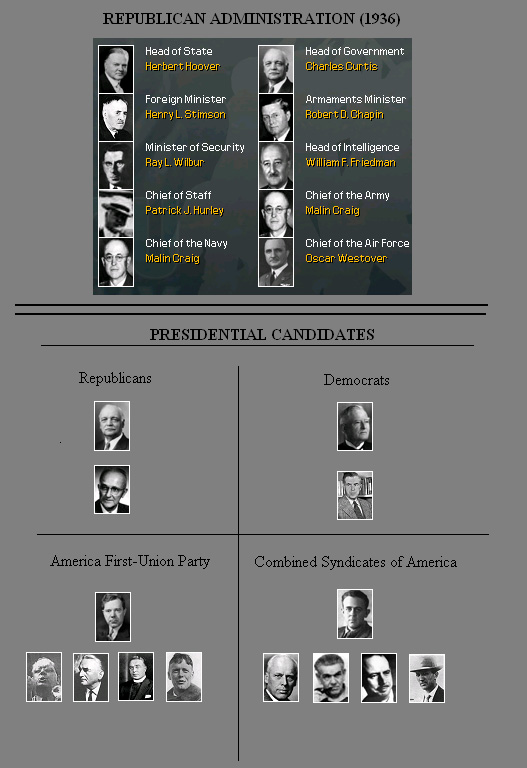United States
From Kaiserreich
This is a placehoder. Someone else can do this much better than me. Just copying word from word from the KR forums.
THE UNITED STATES OF AMERICA
While the United States economy grew tremendously during the Weltkrieg, with American banks and factories supplying the Entente war effort, the 1920s were disastrous. The military and political collapse of France and Britain meant that any American investments or loans to these two countries were irrecoverably lost. German dominance over world trade ensured that America was progressively forced out of markets in Europe, Africa, Asia and even parts of South America. A slow but inexorable economic decline ensued, followed by an increasingly vicious social conflict.
Up until now, the two party system has been held in place, with both Democrats and Republicans maintaining the support of American industry and big business, and with any extremist groups being fragmented and disunited. However, the inefficient second term of President Hoover’s Presidency has seen a significant shift in the political constellation of America. Two grand coalitions have formed, one uniting the forces of the populist and technocratic right, and the other the revolutionary left, and are both mobilising to fight for their own man to become the 32nd President of the United States in 1936.
During the Presidential Elections of 1936, Herbert Hoover is to step down, and his Vice President, Charles Curtis is to run for the Presidency as the Republican Candidate, with Frank Knox as his running mate. John Nance Garner, supported by Henry A. Wallace, is the candidate for the Democrats.
The America First-Union Party has selected Huey Long, Governor of Louisiana, as its candidate. With its support primarily coming from the depressed agricultural regions of the South and Mid-West, the new party combines traditional populism with neo-capitalist modes of organisation, demanding redistribution of wealth and social welfare, but within a strong centralised corporatist economic structure, controlled by a paternalistic economic and political elite.
The Combined Syndicates of America are led by Jack Reed, who was turned into a savvy political operator during his time in Russia during its revolution and civil war. Uniting various shades of socialist, syndicalist and communist opinion, the CSA have mobilised the surging throngs of workers in America's industrial heartlands.
The predicted breakdown of support by region is as follows:
(Pic goes here. In Process)
(Blue – Marginal Democrat or Republican; Green – Almost certain Democrat or Republican; Yellow – America First-Union; Red – Combined Syndicates of America)
All sides are currently organising for the elections, and are restraining their supporters from resorting to violence. But, should the result not move in their favour, the two radical parties have both built formidable voluntarist and paramilitary organisations, which could quickly replace the authority of the Federal Government in their areas of dominance. Likewise, unlike the rest of the country, California and the Western States have prospered, largely thanks to maritime trade with Russia and Japan, and so would be unwilling to submit to any overly radical programme. And the views of the military regarding this potential impending social collapse are at present unclear…
Will the Union survive the crisis years of 1936 and 1937? Will political a new order in America arise to end almost a century and a half of constitutional government? Or will a second civil war, even more bloody and catastrophic than the first, tear the world’s last great Republic apart?

